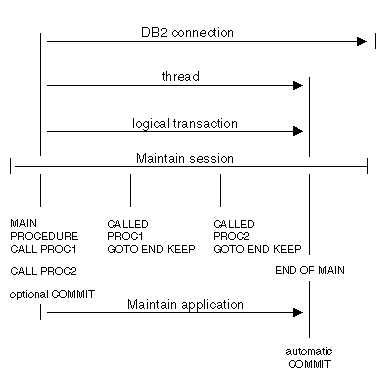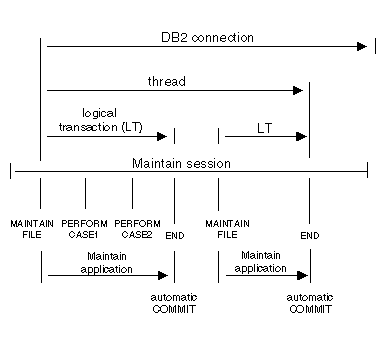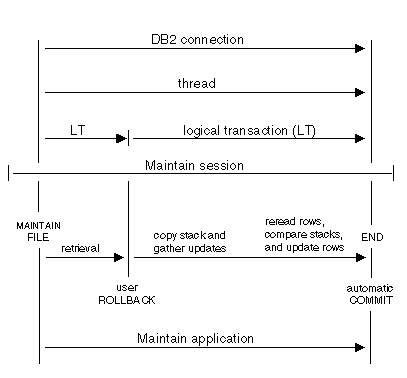Ensuring Transaction Integrity for DB2 Data Sources
In this section: Reference: |
DB2 ensures transaction integrity by locking data source
rows when they are read. The behavior of a lock depends on the isolation
level of a transaction. The techniques suggested here for WebFOCUS
Maintain applications all use an isolation level of repeatable read.
Repeatable read involves a trade-off: it ensures absolute transaction integrity,
but it can prevent other users from accessing a row for long periods
of time, creating performance bottlenecks.
Under repeatable read, a row is locked when it is retrieved from
the data source, and is released when the transaction that retrieved
the row is either committed to the data source or rolled back. A
Maintain DB2 transaction is committed or rolled back each time a WebFOCUS
Maintain application issues a COMMIT or ROLLBACK command. You explicitly code
COMMIT and ROLLBACK commands in your WebFOCUS Maintain application;
in some circumstances the application may also issue these commands
implicitly, as described in Designing Transactions That Span Procedures, and in When an Application Ends With an Open Transaction.
We recommend two strategies for writing
transactions to DB2 data sources:
-
Using Transaction Locking to Manage DB2 Row Locks.
This locks each row for the duration of the transaction, from the
time a row is retrieved, until the transaction is committed. In effect,
it relies on DB2 to ensure transaction integrity. This is simpler
to code, but keeps rows locked for a longer period of time. This
is the preferred strategy, unless the duration of its locks interferes
excessively with your data source concurrency requirements.
-
Using Change Verification to Manage DB2 Row Locks.
This locks each row while it is being retrieved, releases the lock,
and then relocks the row shortly before writing it to the data source. This
technique ensures transaction integrity by verifying, before writing
each row, that the row has not been changed by other users in the
interim. This is more complex to code, but locks rows for a shorter
period of time, increasing data availability. (For information about
applying change verification, for all types of data sources, to applications
designed for Shared Application Servers, see Running WebFOCUS Maintain Applications.
While these strategies are described for use with DB2 data sources,
you can also apply them to transactions against other kinds of data
sources, changing DBMS-specific details when necessary.
x
Reference: How WebFOCUS Maintain DB2 Logic Differs From Other IBI Products
If
you are familiar with using the DB2 Data Adapter with Information
Builders products other than WebFOCUS Maintain, note that WebFOCUS Maintain
works with DB2 a bit differently:
xUsing Transaction Locking to Manage DB2 Row Locks
You can use the transaction locking strategy to manage
DB2 row locks in WebFOCUS Maintain applications. While this strategy
is described for use with DB2 data sources, you can also apply it
to transactions against other kinds of data sources, changing DBMS-specific
details when necessary. When using transaction locking, your application locks
each row with an isolation level of repeatable read for the duration
of the transaction, from the time it retrieves the row, until the
time it commits or rolls back the transaction.
The following illustration shows the duration of connections,
threads, and logical transactions (also known as logical units of
work) when you use this strategy:

If your applications are small in scope, comprising only a single
procedure, the duration of connections, threads, and logical transactions
would look like this:

Compared to the Using Change Verification to Manage DB2 Row Locks, transaction locking is simpler to
code, but keeps rows locked for a longer period of time. This may
cause other users to experience time outs, in which case DB2 will
return a -911 or -904 SQL code. You can mitigate the effect of row
locking by:
- Keeping the
size of the transaction small, making it less likely that another user
will encounter a row locked by your transaction.
- Implementing
the change verification strategy described in Using Change Verification to Manage DB2 Row Locks.
- Having user
applications check for a locked condition when retrieving rows,
and upon encountering a lock, re-issuing the retrieval request a
specified number of times in a loop. If the user application exceeds
the specified number of attempts, have it display a message to the
user indicating that the row is in use, and suggesting that the user
try again later.
- Using standard
database administration techniques such as report scheduling, tablespace
management, and data warehousing.
x
Procedure: How to Implement Transaction Locking for DB2
To
implement the transaction locking strategy for managing DB2 row
locks in WebFOCUS Maintain applications, bind the DB2 Data Adapter
plan with an isolation level of repeatable read. (The isolation
level is a DB2 Data Adapter installation BIND PLAN parameter.) In
your WebFOCUS Maintain application:
-
Read the rows. Retrieve
all required rows. Retrieval locks the rows with an isolation level
of repeatable read.
-
Write the transaction to the data source. Apply
the updates of the transaction to the data source.
-
Be sure to terminate called procedures correctly. If
a Maintain procedure calls another Maintain procedure within the
scope of a transaction, the called procedure must return control
using the GOTO END KEEP command. For more information about GOTO
END KEEP, see Designing Transactions That Span Procedures.
Caution: If any called procedure within the scope
of a transaction returns control without GOTO END KEEP, Maintain
issues an implied COMMIT command, releasing all row locks and making
the application vulnerable to updates by other users. Be sure to
return control using GOTO END KEEP; otherwise, code each transaction
within a single procedure, so that the scope of each transaction
does not extend beyond one procedure, or use the change verification
strategy described in Using Change Verification to Manage DB2 Row Locks.
-
Close the transaction. When
the transaction is complete, close it by issuing a COMMIT or ROLLBACK
command. The COMMIT or ROLLBACK command releases all row locks.
xUsing Change Verification to Manage DB2 Row Locks
You can use the change verification strategy to manage
DB2 row locks in WebFOCUS Maintain applications. While this strategy
is described for use with DB2 data sources, you can also apply it
to transactions against other kinds of data sources by changing
DBMS-specific details when necessary. For information about applying
change verification, for all types of data sources, to applications
designed for Shared Application Servers, see Developing an Application for a Shared Application Server.
When using change verification, your application retrieves all
needed rows into a stack, locking them in the process; releases
the locks after retrieval; and then performs all updates against
the stack (not against the data source). This enables you
to work with the data in the stack as long as necessary without
preventing other users from accessing the data source. When you
are ready to close the transaction, you retrieve the original rows
from the data source again, relocking them in the process. You then
compare their current values in the data source to their original
values when you first retrieved them, and write the transaction
to the data source if the values are the same, that is, if the rows have
not been changed by other users in the interim.
Change verification enables the maximum number of users to access
the same data concurrently, and makes it possible to write the maximum
number of transactions in the shortest time. It is able to do this
because it is an optimistic locking protocol, that is, it is optimized
for the most common situation, in which at any moment, at most one
user will attempt to update a given row. Compared to the Using Transaction Locking to Manage DB2 Row Locks, this
is more complex to code, but locks rows for less time, increasing
data availability.
The following illustration shows the duration of connections,
threads, and logical transactions when you use this strategy for
DB2 data sources:

x
Procedure: How to Implement Change Verification for DB2
To
implement the change verification strategy for managing DB2 row
locks in WebFOCUS Maintain applications, bind the DB2 Data Adapter
plan with an isolation level of repeatable read. (The isolation
level is a DB2 Data Adapter installation BIND PLAN parameter.) In
your WebFOCUS Maintain application:
-
Read the rows. Retrieve
all required rows into a stack (for example, Stack1). Retrieval
locks the rows with an isolation level of repeatable read.
-
Free the row locks. Issue
a ROLLBACK command immediately following retrieval in order to release
all row locks.
-
Copy the stack. Make
a copy of the stack (for example, Stack2). You will use this copy
later when checking for changes.
-
Write the transaction to the stack. Apply
the updates of the transaction to the rows in the original stack
(Stack1).
-
Read the rows again. Retrieve
the rows of the transaction from the data source into a new stack
(for example, Stack3). Retrieval relocks the rows with an isolation
level of repeatable read.
-
Verify changes. Compare
the original data source values in the copy of the original stack
(that is, Stack2) to the current data source values (that is, Stack3)
to verify that other users have not changed these rows in the interim.
-
Write the transaction to the data source. If
any of these rows have been changed in the data source by another
user, you can roll back the transaction or take some other action,
as your application logic requires. If none of the rows in the transaction
have been changed by other users in the interim, your application
can apply the transaction's updates to the data source, and issue
a COMMIT command to commit the transaction.
The COMMIT or ROLLBACK command releases all row locks.


